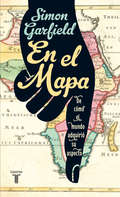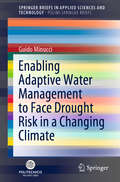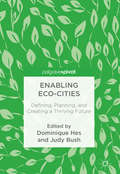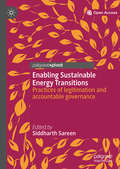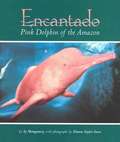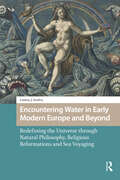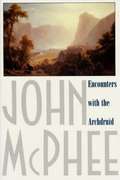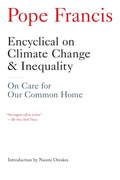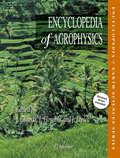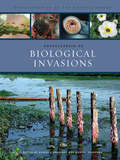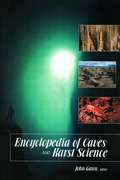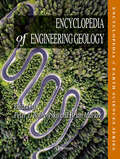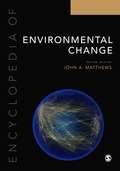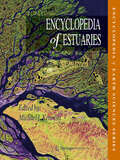- Table View
- List View
Emulating Natural Forest Landscape Disturbances: Concepts and Applications (Forest Research Information Paper Ser. #No. 149)
by Lisa J. Buse Michael G. Weber Eds. Perera Ajith H.What is a natural forest disturbance? How well do we understand natural forest disturbances and how might we emulate them in forest management? What role does emulation play in forest management? Representing a range of geographic perspectives from across Canada and the United States, this book looks at the escalating public debate on the viability of natural disturbance emulation for sustaining forest landscapes from the perspective of policymakers, forestry professionals, academics, and conservationists. This book provides a scientific foundation for justifying the use of and a solid framework for examining the ambiguities inherent in emulating natural forest landscape disturbance. It acknowledges the divergent expectations that practitioners face and offers a balanced view of the promises and challenges associated with applying this emerging forest management paradigm.The first section examines foundational concepts, addressing questions of what emulation involves and what ecological reasoning substantiates it. These include a broad overview, a detailed review of emerging forest management paradigms and their global context, and an examination of the ecological premise for emulating natural disturbance. This section also explores the current understanding of natural disturbance regimes, including the two most prevalent in North America: fire and insects. The second section uses case studies from a wide geographical range to address the characterization of natural disturbances and the development of applied templates for their emulation through forest management. The emphasis on fire regimes in this section reflects the greater focus that has traditionally been placed on understanding and managing fire, compared with other forms of disturbance, and utilizes several viewpoints to address the lessons learned from historical disturbance patterns. Reflecting on current thinking in the field, immediate challenges, and potential directions, the final section moves deeper into the issues of practical applications by exploring the expectations for and feasibility of emulating natural disturbance through forest management.
En el mapa. De cómo el mundo adquirió su aspecto
by Simon GarfieldLos mapas nos fascinan. Plasman lo que conocemos del mundo y registran nuestros progresos pero, sobre todo, cuentan nuestra historia. Imagine un mundo sin ellos. ¿Cómo viajaríamos? ¿Podríamos reclamar la propiedad de una tierra? ¿Hasta dónde se extenderían los países? ¿Sobre qué discutirían hombres y mujeres en el coche? Remontándose a los primeros dibujos de filósofos y exploradores hasta llegar a Google Maps y el GPS, Simon Garfield examina la singular manera en la que los mapas reflejan lo mejor y lo peor de lo que nos hace humanos: el descubrimiento y la curiosidad, el conflicto y la destrucción. Este libro, ingenioso y lleno de anécdotas, constituye un rico mosaico de historias fascinantes: desde la búsqueda del globo terráqueo perfecto o las dificultades de cartografiar África y la Antártida hasta la confección de los intrigantes mapas de tesoros ocultos, los sublimes mappae mundi medievales, el bautizo de América, los orígenes de las primeras guías de viaje o los fraudes más sorprendentes.
Enabling Adaptive Water Management to Face Drought Risk in a Changing Climate (SpringerBriefs in Applied Sciences and Technology)
by Guido MinucciThis book explores the current challenges with regard to uncertainty and risk in water management, as well as the interlinkages between drought and water management. It focuses on the challenges for water management organisations, which are expected to adapt to such changes and implement adaptive water management. The book proposes a methodology for assessing organisations’ adaptive capacity, named REACT, and demonstrates its application in a case study. It subsequently analyses the barriers hindering water management organisations’ ability to adapt, and investigates the socio-cultural and economic barriers in water governance to applying adaptive water management (AWM) strategies. Lastly, the book describes how to enable AWM in order to face current and future drought risks by integrating it with drought risk management. Given its scope, it will appeal to scientists, pracademics and professionals from academia, the water industry and involved in policymaking.
Enabling Asia to Stabilise the Climate
by Shuzo NishiokaThis book presents good practices in Asia and ASEAN countries for effectively promoting advances in response to climate change, which can help to achieve sustainable development in Asia and around the world. As a proposal, the aim is to influence the discussions at COP 21 by providing a positive agenda with concrete actions from an Asian perspective. The book is divided into three parts. Part 1 describes the greenhouse gas (GHG) reduction scenario from an Asian perspective and in line with global 2 ° targets. Based on modeling analysis, the studies demonstrate the theoretical potentials and send the policymakers at COP 21 the positive message that "Asia can reach the target. " As Asian countries vary in terms of their economic strength, country-specific scenario studies for the two giants China and India as well as for Japan and Vietnam are introduced to show the different approaches for each country. Part 2 shows successful examples of how modeling analysis are reflected in actual policy development, which provides practical guidelines to help policymakers develop their own roadmaps with stakeholder dialogue, not only in Asia but also in other regions of the world. The Nationally Appropriate Mitigation Action (NAMA) roadmap development in Thailand as well as the Iskandar Malaysia project show at the country and city level how researchers and policymakers are working closely to succeed. Part 3 focuses on a number of sector-specific activities including transportation, forestry, capacity development, and inventory work in Asia. Rather than discussing the Low Carbon Society (LCS) concept in detail, the respective chapters highlight unique, concrete, and practically applicable examples from Asia, showing how Asian countries are addressing climate change mitigation issues in a collaborative manner, an approach that can be replicated in other regions. While the ultimate goal of this book is to facilitate international climate regime making, local government and international organizations (United Nations, World Bank, and others) officers, researchers, international NGO/NPOs, consultants, students (particularly those studying international relationships or environmental studies), as well as reporters will find this book useful in broadening their understanding of low-carbon development in Asia.
Enabling Eco-Cities
by Dominique Hes Judy BushCities are striving to become more resilient, adaptive and sustainable; this requires new ways of governing and developing the city. This book features chapters by researchers using regenerative development and transitions theories to envisage how Eco-Cities could be planned, designed and created, and concludes with practical tools and an outline of how this evolution could be facilitated. It examines two major questions: How can we use understandings of Eco-Cities to address the legacy of urban built form and existing practices which often make it difficult to create the systemic changes needed? And what are the elements of complex urban places and spaces that will enable the planning, creation and evolution of thriving cities?The book will appeal to planners, city makers, urban researchers, students and practitioners, including planners, designers, architects and sustainability managers, and all those seeking to envisage the steps along the path to thriving cities of the future.
Enabling Sustainable Energy Transitions: Practices of legitimation and accountable governance
by Siddharth SareenThis open access book reframes sustainable energy transitions as being a matter of resolving accountability crises. It demonstrates how the empirical study of several practices of legitimation can analytically deconstruct energy transitions, and presents a typology of these practices to help determine whether energy transitions contribute to sustainability.The real-world challenge of climate change requires sustainable energy transitions. This presents a crisis of accountability legitimated through situated practices in a wide range of cases including: solar energy transitions in Portugal, urban energy transitions in Germany, forestland conflicts in Indonesia, urban carbon emission targets in Norway, transport electrification in the Nordic region, and biodiversity conservation and energy extraction in the USA. By synthesising these cases, chapters identify various dimensions wherein practices of legitimation construct specific accountability relations. This book deftly illustrates the value of an analytical approach focused on accountable governance to enable sustainable energy transitions. It will be of great use to both academics and practitioners working in the field of energy transitions.
Encantado
by Sy Montgomery Dianne Taylor-SnowWelcome to a forest filled with water. In the wet season, the swollen Amazon becomes a looking glass into another world, where pink dolphins swim like something from a dream. In Peru they are called bufeo colorado-the ruddy dolphin. Their color ranges from white to gray to a vivid pink. These astonishing mammals, actually river-dwelling whales, easily navigate their way through the complex, hazardous world of the Amazon rain forest. Encantado invites readers on the adventure of a lifetime as we travel into one of the world's most lush and beautiful jungles in search of these magical creatures. Our guides include scientists and researchers as well as the local people, who have lived with the encantados-the enchanted ones-literally at their doorsteps for centuries. Our main guides are the dolphins themselves. They lead us into myth. They take us back in time to a prehistoric era. They alone can show us the depth of the Amazon's beauty, diversity, and magic-and help us to keep our planet rich and whole.
Enchantment and Exploitation: The Life and Hard Times of a New Mexico Mountain Range, Revised and Expanded Edition
by William deBuysFirst published in 1985, William deBuys&’s Enchantment and Exploitation has become a New Mexico classic. It offers a complete account of the relationship between society and environment in the Sangre de Cristo Mountains of northern New Mexico, a region unique in its rich combination of ecological and cultural diversity. Now, more than thirty years later, this revised and expanded edition provides a long-awaited assessment of the quality of the journey that New Mexican society has traveled in that time—and continues to travel.In a new final chapter deBuys examines ongoing transformations in the mountains&’ natural systems—including, most notably, developments related to wildfires—with significant implications for both the land and the people who depend on it. As the climate absorbs the effects of an industrial society, deBuys argues, we can no longer expect the environmental future to be a reiteration of the environmental past.
Enclosed Experimental Ecosystems and Scale
by W. Michael Kemp John E. Petersen William C. Dennison Victor S. KennedyEnclosed ecosystem experiments have gained in popularity as research tools in ecological science, particularly in the study of coastal aquatic environments. These systems provide scientists with a degree of experimental control that is not achievable through field experiments. Yet to date, techniques for systematically extrapolating results from small-scale experimental ecosystems to larger, deeper, more open, more biologically diverse, and more heterogeneous ecosystems in nature have not been well developed. Likewise, researchers have lacked methods for comparing and extrapolating information among natural ecosystems that differ in scale. Enclosed Experimental Ecosystems and Scale: Tools for Understanding and Managing Coastal Ecosystems provides scientists, managers, and policy makers with an introduction to what has been termed the "problem of scale", and presents information that will allow for improved design and interpretation of enclosed experimental aquatic ecosystems. The book integrates the results of a 10-year research project involving a multi-disciplinary team of scientists and students to explore scale-related questions in a variety of coastal habitats. Anticipating use as a reference, the book has been designed so that individual sections and individual pages can function as stand alone units.
Encountering Toponymic Geopolitics: Place Names as a Political Instrument in the Post-Soviet States (Routledge Geopolitics Series)
by Sergei BasikThis book provides cutting-edge insights on contemporary geopolitical toponymic policy and practice in post-Soviet countries. It examines the political features of place naming as a reflection of contemporary political discourse. With multidisciplinary insights from leading scholars, chapters explore a range of topics drawing on critical political toponymy and traditional methods. Contributions examine how the toponymic system can act as a symbol of national identity, the regional geopolitics of toponymy, and geopolitical patterns in contemporary renaming. The historical roots of toponymic decolonization are analyzed, as well as indigenous toponymy and politics, and toponymic aspects of people's daily lives. The book explores a wide range of processes in the post-Soviet realm, including power, identity, economy, social order, and how political power is changing/transforming. It considers how these processes are distributed through various geopolitical and political-economic technologies. Offering empirically rich research from a variety of regions to give insights beyond "Western" perspectives, this book is the first to provide an in-depth exploration of post-Soviet place naming. It will appeal to students and researchers in human geography, politics, sociology, Eastern European studies, onomastics and cultural studies.
Encountering Water in Early Modern Europe and Beyond: Redefining the Universe through Natural Philosophy, Religious Reformations, and Sea Voyaging (Environmental Humanities in Pre-modern Cultures)
by Lindsay StarkeyBoth the Christian Bible and Aristotle’s works suggest that water should entirely flood the earth. Though many ancient, medieval, and early modern Europeans relied on these works to understand and explore the relationships between water and earth, sixteenth-century Europeans particularly were especially concerned with why dry land existed. This book investigates why they were so interested in water’s failure to submerge the earth when their predecessors had not been. Analyzing biblical commentaries as well as natural philosophical, geographical, and cosmographical texts from these periods, Lindsay Starkey shows that European sea voyages to the southern hemisphere combined with the traditional methods of European scholarship and religious reformations led sixteenth-century Europeans to reinterpret water and earth’s ontological and spatial relationships. The manner in which they did so also sheds light on how we can respond to our current water crisis before it is too late.
Encounters With The Archdruid
by John McpheeThe narratives in this book are of journeys made in three wildernesses - on a coastal island, in a Western mountain range, and on the Colorado River in the Grand Canyon. The four men portrayed here have different relationships to their environment, and they encounter each other on mountain trails, in forests and rapids, sometimes with reserve, sometimes with friendliness, sometimes fighting hard across a philosophical divide.
Encounters and Engagements between Economic and Cultural Geography
by Barney WarfThe intellectual renaissance of human geography has included a widespread engagement between its economic and cultural subdisciplines. This volume adopts a variety of conceptual and empirical perspectives on the encounters between economic and cultural geographers. It offers an introduction and 10 chapters by authors in a variety of national contexts to explicate issues such as the cultural turn in economic geography, the cultural construction of economic geographic thought, consumption, gender, everyday life, commodity chain analysis, trust, networks, the creative economy, and tourism. The volume contains empirical analyses utilizing both quantitative and qualitative approaches at spatial scales ranging from the individual to the global economy. In illustrating how human geographers can ill afford to subscribe to the analytically false dichotomy between "culture" and "the economy," the book explicates how cultural and economic geography can be seamlessly integrated , bringing them into a creative tension to their mutual benefit.
Encounters in the New World: Jesuit Cartography of the Americas
by Mirela AlticAnalyzing more than 150 historical maps, this book traces the Jesuits’ significant contributions to mapping and mapmaking from their arrival in the New World. In 1540, in the wake of the tumult brought on by the Protestant Reformation, Saint Ignatius of Loyola founded the Society of Jesus, also known as the Jesuits. The Society’s goal was to revitalize the faith of Catholics and to evangelize to non-Catholics through charity, education, and missionary work. By the end of the century, Jesuit missionaries were sent all over the world, including to South America. In addition to performing missionary and humanitarian work, Jesuits also served as cartographers and explorers under the auspices of the Spanish, Portuguese, and French crowns as they ventured into remote areas to find and evangelize to native populations. In Encounters in the New World, Mirela Altic analyzes more than 150 of their maps, most of which have never previously been published. She traces the Jesuit contribution to mapping and mapmaking from their arrival in the New World into the post-suppression period, placing it in the context of their worldwide undertakings in the fields of science and art. Altic’s analysis also shows the incorporation of indigenous knowledge into the Jesuit maps, effectively making them an expression of cross-cultural communication—even as they were tools of colonial expansion. This ambiguity, she reveals, reflects the complex relationship between missions, knowledge, and empire. Far more than just a physical survey of unknown space, Jesuit mapping of the New World was in fact the most important link to enable an exchange of ideas and cultural concepts between the Old World and the New.
Encounters in the New World: Jesuit Cartography of the Americas
by Mirela AlticAnalyzing more than 150 historical maps, this book traces the Jesuits’ significant contributions to mapping and mapmaking from their arrival in the New World. In 1540, in the wake of the tumult brought on by the Protestant Reformation, Saint Ignatius of Loyola founded the Society of Jesus, also known as the Jesuits. The Society’s goal was to revitalize the faith of Catholics and to evangelize to non-Catholics through charity, education, and missionary work. By the end of the century, Jesuit missionaries were sent all over the world, including to South America. In addition to performing missionary and humanitarian work, Jesuits also served as cartographers and explorers under the auspices of the Spanish, Portuguese, and French crowns as they ventured into remote areas to find and evangelize to native populations. In Encounters in the New World, Mirela Altic analyzes more than 150 of their maps, most of which have never previously been published. She traces the Jesuit contribution to mapping and mapmaking from their arrival in the New World into the post-suppression period, placing it in the context of their worldwide undertakings in the fields of science and art. Altic’s analysis also shows the incorporation of indigenous knowledge into the Jesuit maps, effectively making them an expression of cross-cultural communication—even as they were tools of colonial expansion. This ambiguity, she reveals, reflects the complex relationship between missions, knowledge, and empire. Far more than just a physical survey of unknown space, Jesuit mapping of the New World was in fact the most important link to enable an exchange of ideas and cultural concepts between the Old World and the New.
Encounters with Florida's Endangered Wildlife
by Doug AldersonEastern bison roamed Florida into the 1800s. Red wolves disappeared in the 1920s. The dusky seaside sparrow was declared extinct in 1990.It's too soon to say whether the 116 threatened, endangered, or imperiled animal species currently found in the state will also fall victim to climate change, extermination, overdevelopment, or poisons. But as long as they remain, there will be men and women who work tirelessly on their behalf.Combining adventure, natural history, and cultural history, Encounters with Florida’s Endangered Wildlife features chapters tracking panthers, black bears, whooping cranes, manatees, sea turtles, even ivory-billed woodpeckers--which may or may not be extinct. Join Doug Alderson as he travels into prairies, woods, springs, and ocean to come face to face with these and other captivating creatures and learns firsthand about their strangled lives and fragile habitats.With a chapter on the impact of non-native populations of Burmese pythons and Rhesus monkeys, as well as a chilling epilogue that imagines the peninsula one hundred years in the future, this book is a must-read for anyone who wants to know more about the current state of wild Florida.
Encounters with Nature Spirits: Co-creating with the Elemental Kingdom
by R. Ogilvie CrombieA fascinating, first-hand account of the vast powers and true nature of the Elemental Kingdom • Reveals deep wisdom, eloquently shared through the author’s encounters with the great God Pan and his elemental subjects • Offers a glimpse into the hidden layers of the natural world and the workings of the elemental kingdom • Includes chapters by Mike Scott, David Spangler, Dorothy Maclean, and Brian Nobbs as well as beautiful illustrations by fine artist Elise Hurst, who perfectly captures the energy of the natural world and its subjects as we might perceive them “To anyone who may have expressed a wish to see and talk to nature spirits . . . remember it took 63 years for my wish to be granted, so don’t lose hope.” Have you ever wished for something with your whole heart? As a child, R. Ogilvie Crombie (Roc) made a wish as he dropped a penny into a wishing well - he asked to be able to see fairies and talk to them. In Encounters with Nature Spirits, we follow Roc’s path as, many years later, he meets the faun Kurmos in the Royal Botanic Garden in Edinburgh, discovers the realm of the elementals, and, eventually, meets the great god Pan himself. In his conversations with Pan, elves, and other nature spirits Roc realizes that the elemental realm is vastly more powerful than our human kingdom and possesses an ability to create far beyond our human means. Through his experiences Roc becomes closely involved with the Findhorn Community in northeast Scotland where he meets further elementals who give him sound advice as to how the famous Findhorn gardens should be cared for in order to work in harmony with nature. Encounters with Nature Spirits is a reminder to us all of the importance of our relationship with the nature kingdom. Through his example, Roc places emphasis on connecting and working in harmony with nature spirits. True co-creation with nature, working with rather than against the elemental kingdom, can bring about vital positive change to our endangered eco-system. The elementals are open to working with mankind--the question is, are we humans open to engaging with and respecting them again?
Encyclical on Climate Change and Inequality
by Pope Francis Naomi OreskesThe complete text of the landmark encyclical letter from Pope Francis that, as Time magazine reported, "rocked the international community"In the Encyclical on Climate Change and Inequality, the beloved Pope exhorts the world to combat environmental degradation and its impact on the poor. In a stirring, clarion call that is not merely aimed at Catholic readers but rather at a wide, lay audience, the Pope cites the overwhelming scientific evidence of climate change, and does not hesitate to detail how it is the result of a historic level of unequal distribution of wealth.It is, in short, as the New York Times labeled it, "An urgent call to action . . . intended to persuade followers around the world to change their behavior, in hopes of protecting a fragile planet." With an insightful and informative introduction by Harvard professor Naomi Oreskes, famed for her bestselling Merchants of Doubt: How a Handful of Scientists Obscured the Truth on Issues from Tobacco Smoke to Global Warming.From the Trade Paperback edition.
Encyclopedia of Agrophysics
by Charles W. Finkl Rainer Horn Eugene V. Shein Jan Gliński Jerzy Lipiec Josse De Baerdemaeker Józef Horabik Krystyna Konstankiewicz Stanislaw Grundas Winfried E. Blum Yakov PachepskyThis Encyclopedia of Agrophysics will provide up-to-date information on the physical properties and processes affecting the quality of the environment and plant production. It will be a "first-up" volume which will nicely complement the recently published Encyclopedia of Soil Science, (November 2007) which was published in the same series. In a single authoritative volume a collection of about 250 informative articles and ca 400 glossary terms covering all aspects of agrophysics will be presented. The authors will be renowned specialists in various aspects in agrophysics from a wide variety of countries. Agrophysics is important both for research and practical use not only in agriculture, but also in areas like environmental science, land reclamation, food processing etc. Agrophysics is a relatively new interdisciplinary field closely related to Agrochemistry, Agrobiology, Agroclimatology and Agroecology. Nowadays it has been fully accepted as an agricultural and environmental discipline. As such this Encyclopedia volume will be an indispensable working tool for scientists and practitioners from different disciplines, like agriculture, soil science, geosciences, environmental science, geography, and engineering.
Encyclopedia of Biological Invasions
by Daniel Simberloff Marcel RejmanekThis pioneering encyclopedia illuminates a topic at the forefront of global ecology--biological invasions, or organisms that come to live in the wrong place. Written by leading scientists from around the world, Encyclopedia of Biological Invasions addresses all aspects of this subject at a global level--including invasions by animals, plants, fungi, and bacteria--in succinct, alphabetically arranged articles. Scientifically uncompromising, yet clearly written and free of jargon, the volume encompasses fields of study including biology, demography, geography, ecology, evolution, sociology, and natural history. Featuring many cross-references, suggestions for further reading, illustrations, an appendix of the world's worst 100 invasive species, a glossary, and more, this is an essential reference for anyone who needs up-to-date information on this important topic. Encyclopedia of Biological Invasions features articles on: * Well-known invasive species such the zebra mussel, chestnut blight, cheatgrass, gypsy moth, Nile perch, giant African snail, and Norway rat * Regions with especially large numbers of introduced species including the Great Lakes, Mediterranean Sea, Hawaiian Islands, Australia, and New Zealand. * Conservation, ecological, economic, and human and animal health impacts of invasions around the world * The processes and pathways involved in invasion * Management of introduced species
Encyclopedia of Caves and Karst Science
by John GunnThe Encyclopedia of Caves and Karst Science contains 350 alphabetically arranged entries. The topics include cave and karst geoscience, cave archaeology and human use of caves, art in caves, hydrology and groundwater, cave and karst history, and conservation and management. The Encyclopedia is extensively illustrated with photographs, maps, diagrams, and tables, and has thematic content lists and a comprehensive index to facilitate searching and browsing.
Encyclopedia of Earthquake Engineering
by Michael Beer Siu-Kui Au Ioannis A. Kougioumtzoglou Edoardo PatelliThe Encyclopedia of Earthquake Engineering is designed to be the authoritative and comprehensive reference covering all major aspects of the science of earthquake engineering, specifically focusing on the interaction between earthquakes and infrastructure. The encyclopedia comprises approximately 300 contributions. Since earthquake engineering deals with the interaction between earthquake disturbances and the built infrastructure, the emphasis is on basic design processes important to both non-specialists and engineers so that readers become suitably well informed without needing to deal with the details of specialist understanding. The encyclopedia's content provides technically-inclined and informed readers about the ways in which earthquakes can affect our infrastructure and how engineers would go about designing against, mitigating and remediating these effects. The coverage ranges from buildings, foundations, underground construction, lifelines and bridges, roads, embankments and slopes. The encyclopedia also aims to provide cross-disciplinary and cross-domain information to domain-experts. This is the first single reference encyclopedia of this breadth and scope that brings together the science, engineering and technological aspects of earthquakes and structures.
Encyclopedia of Engineering Geology (Encyclopedia Of Earth Sciences Ser.)
by Peter T. Bobrowsky Claudio Margottini Paul Marinos Brian Marker Martin G. Culshaw Jerome De Graff Laurance Donnelly Michael Hendry Jeffrey R. Keaton Victor Osipov Abdul Shakoor Roy ShlemonThis volume addresses the multi-disciplinary topic of engineering geology and the environment, one of the fastest growing, most relevant and applied fields of research and study within the geosciences. It covers the fundamentals of geology and engineering where the two fields overlap and, in addition, highlights specialized topics that address principles, concepts and paradigms of the discipline, including operational terms, materials, tools, techniques and methods as well as processes, procedures and implications.A number of well known and respected international experts contributed to this authoritative volume, thereby ensuring proper geographic representation, professional credibility and reliability. This superb volume provides a dependable and ready source of information on approximately 300 topical entries relevant to all aspects of engineering geology. Extensive illustrations, figures, images, tables and detailed bibliographic citations ensure that the comprehensively defined contributions are broadly and clearly explained.The Encyclopedia of Engineering Geology provides a ready source of reference for several fields of study and practice including civil engineers, geologists, physical geographers, architects, hazards specialists, hydrologists, geotechnicians, geophysicists, geomorphologists, planners, resource explorers, and many others. As a key library reference, this book is an essential technical source for undergraduate and graduate students in their research. Teachers/professors can rely on it as the final authority and the first source of reference on engineering geology related studies as it provides an exceptional resource to train and educate the next generation of practitioners.
Encyclopedia of Environmental Change: Three Volume Set
by John A MatthewsAccessibly written by a team of international authors, the Encyclopedia of Environmental Change provides a gateway to the complex facts, concepts, techniques, methodology and philosophy of environmental change. This three-volume set illustrates and examines topics within this dynamic and rapidly changing interdisciplinary field. The encyclopedia includes all of the following aspects of environmental change: Diverse evidence of environmental change, including climate change and changes on land and in the oceans Underlying natural and anthropogenic causes and mechanisms Wide-ranging local, regional and global impacts from the polar regions to the tropics Responses of geo-ecosystems and human-environmental systems in the face of past, present and future environmental change Approaches, methodologies and techniques used for reconstructing, dating, monitoring, modelling, projecting and predicting change Social, economic and political dimensions of environmental issues, environmental conservation and management and environmental policy Over 4,000 entries explore the following key themes and more: Conservation Demographic change Environmental management Environmental policy Environmental security Food security Glaciation Green Revolution Human impact on environment Industrialization Landuse change Military impacts on environment Mining and mining impacts Nuclear energy Pollution Renewable resources Solar energy Sustainability Tourism Trade Water resources Water security Wildlife conservation The comprehensive coverage of terminology includes layers of entries ranging from one-line definitions to short essays, making this an invaluable companion for any student of physical geography, environmental geography or environmental sciences.
Encyclopedia of Estuaries
by Michael J. KennishThe Encyclopedia of Estuaries, part of Springer's Encyclopedia of Earth Sciences Series, provides a single, state-of-the-art, comprehensive reference volume on estuaries for research scientists, educators, students, and others. Consisting of hundreds of subject entries in an easy-to-use format, this volume covers the physical, chemical, and biological characteristics of estuaries. Authors from around the world have contributed to the encyclopedia on such diverse subjects as biotic communities, essential habitats, food webs, fisheries, hydrology, pollution, conservation, and many more. The Encyclopedia of Estuaries will meet the needs of professionals worldwide by supplying detailed information from world-class estuarine and marine scientists as well as experts from other fields of study. The Editor: Michael J. Kennish is a world-class estuarine scientist and a research professor in the Institute of Marine and Coastal Sciences at Rutgers University, New Brunswick, New Jersey (USA). In addition to his research on estuaries, Dr. Kennish has conducted biological and geological research on coastal ocean and deep-sea environments. Much of his research has involved the development and application of innovative methods to assess anthropogenic impacts and to determine the condition and health of coastal ecosystems. Dr. Kennish is the author or editor of 13 scholarly books in marine science, and he is the author or co-author of more than 170 articles in science journals and books. In addition, he has edited 7 compendium science journal special issues on various topics in marine science.

